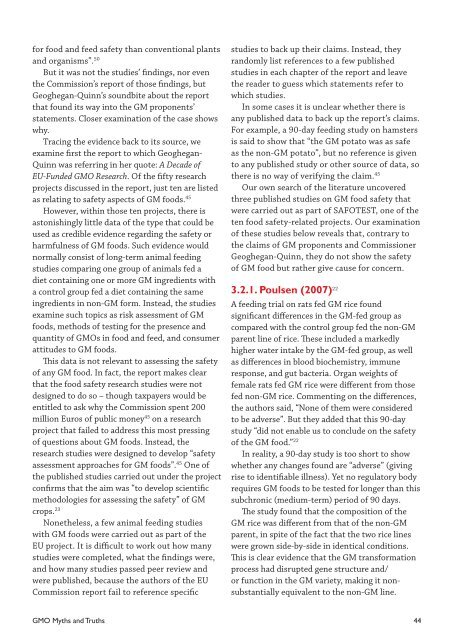GMO Myths and Truths
GMO Myths and Truths
GMO Myths and Truths
You also want an ePaper? Increase the reach of your titles
YUMPU automatically turns print PDFs into web optimized ePapers that Google loves.
for food <strong>and</strong> feed safety than conventional plants<br />
<strong>and</strong> organisms”. 50<br />
But it was not the studies’ findings, nor even<br />
the Commission’s report of those findings, but<br />
Geoghegan-Quinn’s soundbite about the report<br />
that found its way into the GM proponents’<br />
statements. Closer examination of the case shows<br />
why.<br />
Tracing the evidence back to its source, we<br />
examine first the report to which Geoghegan-<br />
Quinn was referring in her quote: A Decade of<br />
EU-Funded <strong>GMO</strong> Research. Of the fifty research<br />
projects discussed in the report, just ten are listed<br />
as relating to safety aspects of GM foods. 45<br />
However, within those ten projects, there is<br />
astonishingly little data of the type that could be<br />
used as credible evidence regarding the safety or<br />
harmfulness of GM foods. Such evidence would<br />
normally consist of long-term animal feeding<br />
studies comparing one group of animals fed a<br />
diet containing one or more GM ingredients with<br />
a control group fed a diet containing the same<br />
ingredients in non-GM form. Instead, the studies<br />
examine such topics as risk assessment of GM<br />
foods, methods of testing for the presence <strong>and</strong><br />
quantity of <strong>GMO</strong>s in food <strong>and</strong> feed, <strong>and</strong> consumer<br />
attitudes to GM foods.<br />
This data is not relevant to assessing the safety<br />
of any GM food. In fact, the report makes clear<br />
that the food safety research studies were not<br />
designed to do so – though taxpayers would be<br />
entitled to ask why the Commission spent 200<br />
million Euros of public money 45 on a research<br />
project that failed to address this most pressing<br />
of questions about GM foods. Instead, the<br />
research studies were designed to develop “safety<br />
assessment approaches for GM foods”. 45 One of<br />
the published studies carried out under the project<br />
confirms that the aim was “to develop scientific<br />
methodologies for assessing the safety” of GM<br />
crops. 23<br />
Nonetheless, a few animal feeding studies<br />
with GM foods were carried out as part of the<br />
EU project. It is difficult to work out how many<br />
studies were completed, what the findings were,<br />
<strong>and</strong> how many studies passed peer review <strong>and</strong><br />
were published, because the authors of the EU<br />
Commission report fail to reference specific<br />
studies to back up their claims. Instead, they<br />
r<strong>and</strong>omly list references to a few published<br />
studies in each chapter of the report <strong>and</strong> leave<br />
the reader to guess which statements refer to<br />
which studies.<br />
In some cases it is unclear whether there is<br />
any published data to back up the report’s claims.<br />
For example, a 90-day feeding study on hamsters<br />
is said to show that “the GM potato was as safe<br />
as the non-GM potato”, but no reference is given<br />
to any published study or other source of data, so<br />
there is no way of verifying the claim. 45<br />
Our own search of the literature uncovered<br />
three published studies on GM food safety that<br />
were carried out as part of SAFOTEST, one of the<br />
ten food safety-related projects. Our examination<br />
of these studies below reveals that, contrary to<br />
the claims of GM proponents <strong>and</strong> Commissioner<br />
Geoghegan-Quinn, they do not show the safety<br />
of GM food but rather give cause for concern.<br />
3.2.1. Poulsen (2007) 22<br />
A feeding trial on rats fed GM rice found<br />
significant differences in the GM-fed group as<br />
compared with the control group fed the non-GM<br />
parent line of rice. These included a markedly<br />
higher water intake by the GM-fed group, as well<br />
as differences in blood biochemistry, immune<br />
response, <strong>and</strong> gut bacteria. Organ weights of<br />
female rats fed GM rice were different from those<br />
fed non-GM rice. Commenting on the differences,<br />
the authors said, “None of them were considered<br />
to be adverse”. But they added that this 90-day<br />
study “did not enable us to conclude on the safety<br />
of the GM food.” 22<br />
In reality, a 90-day study is too short to show<br />
whether any changes found are “adverse” (giving<br />
rise to identifiable illness). Yet no regulatory body<br />
requires GM foods to be tested for longer than this<br />
subchronic (medium-term) period of 90 days.<br />
The study found that the composition of the<br />
GM rice was different from that of the non-GM<br />
parent, in spite of the fact that the two rice lines<br />
were grown side-by-side in identical conditions.<br />
This is clear evidence that the GM transformation<br />
process had disrupted gene structure <strong>and</strong>/<br />
or function in the GM variety, making it nonsubstantially<br />
equivalent to the non-GM line.<br />
<strong>GMO</strong> <strong>Myths</strong> <strong>and</strong> <strong>Truths</strong> 44


